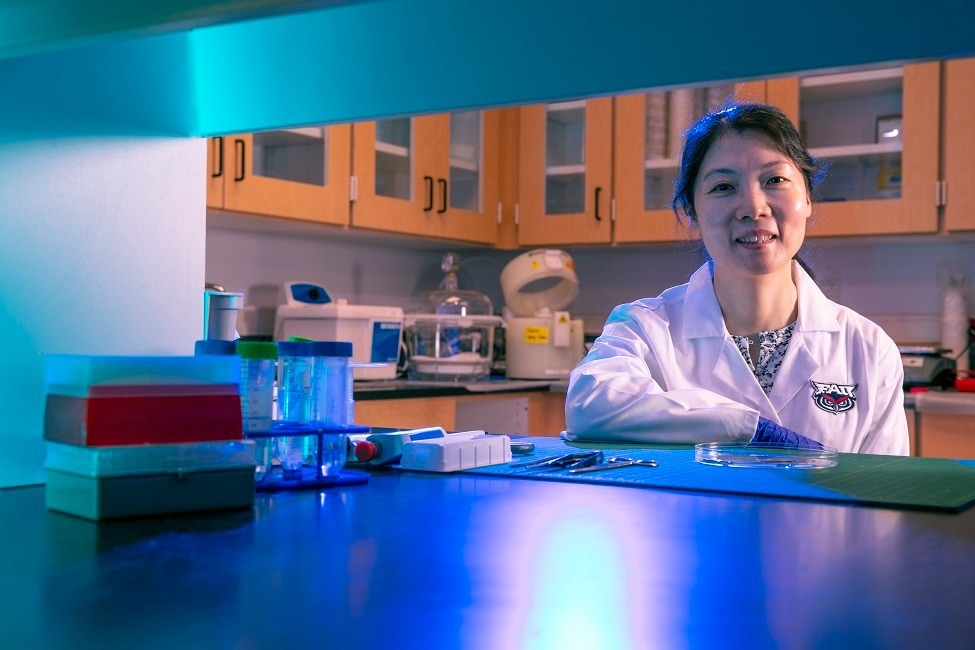Reviewed by Danielle Ellis, B.Sc.Sep 27 2022
Plasmodium falciparum infections can result in placental malaria, which can have serious consequences for both mother and child. Nearly 200,000 newborn fatalities annually from placental malaria, primarily as a result of low birth weight, as well as 10,000 maternal deaths.
 Sarah E. Du, Ph.D., senior author and an associate professor in FAU’s Department of Ocean and Mechanical Engineering. Image Credit: Alex Dolce
Sarah E. Du, Ph.D., senior author and an associate professor in FAU’s Department of Ocean and Mechanical Engineering. Image Credit: Alex Dolce
Red blood cells with parasite infections become trapped inside the placenta’s branch-like structures, which is how placental malaria is caused.
Due to ethical issues and the inaccessibility of living organs, research on the human placenta presents a challenge in terms of experimental design. Modern in vitro models cannot readily recreate the intricate anatomy of the real placenta and the architecture of the maternal-fetal interface, such as the blood flow between the mother and the fetus.
The Schmidt College of Medicine and the College of Engineering and Computer Science at Florida Atlantic University collaborated to create a placenta-on-a-chip model that simulates the nutrition exchange between the mother and fetus while placental malaria is active.
This unique 3D model combines microbiology and engineering technology to examine the intricate processes that occur in malaria-infected placentas as well as other placenta-related diseases and disorders.
The placenta-on-a-chip model replicates the milieu of the malaria-infected placenta in this flow scenario by simulating blood flow. This approach allows researchers to closely monitor the interaction between the infected red blood cells and the placental vasculature.
Using a molecule called CSA that is expressed by the placenta, they are able to quantify the glucose diffusion over the modeled placental barrier and the impact of blood contaminated with a P. falciparum line that can stick to the placenta’s surface.
To conduct the study, human umbilical vein endothelial cells and trophoblasts, or the outer layer cells of the placenta, were cultured on opposing sides of an extracellular matrix gel in a compartmental microfluidic system. This created a physiological barrier between the co-flow tubular structure to simulate a streamlined maternal-fetal interface in placental villi.
Results were shown to increase resistance to the simulated placental barrier for glucose perfusion and decrease the glucose transfer across this barrier in erythrocytes that were CSA-binding infected, according to research published in Scientific Reports.
This crucial aspect of placental malaria pathology is better understood by comparing the rate at which glucose crosses the placental barrier when uninfected or P. falciparum-infected blood flows on outer layer cells. This comparison could also serve as a model for research into possible treatments for placental malaria.
Despite advances in biosensing and live cell imaging, interpreting transport across the placental barrier remains challenging. This is because placental nutrient transport is a complex problem that involves multiple cell types, multi-layer structures, as well as coupling between cell consumption and diffusion across the placental barrier.”
Sarah E. Du, Study Senior Author and Associate Professor, Department of Ocean and Mechanical Engineering, Florida Atlantic University
Du added, “Our technology supports formation of micro engineered placental barriers and mimics blood circulations, which provides alternative approaches for testing and screening.”
The majority of the molecular transfer between maternal and fetal blood takes place in villous trees, which are branching tree-like structures.
The intervillous area that opens to infected red blood cells and white blood cells at the beginning of the second trimester is when placental malaria could develop, thus the researchers were interested in the placental model of the maternal-fetal interface formed during the second half of pregnancy.
This study provides vital information on the exchange of nutrients between mother and fetus affected by malaria. Studying the molecular transport between maternal and fetal compartments may help to understand some of the pathophysiological mechanisms in placental malaria. Importantly, this novel microfluidic device developed by our researchers at Florida Atlantic University could serve as a model for other placenta-relevant diseases.”
Stella Batalama, Dean, College of Engineering and Computer Science, Florida Atlantic University
Source:
Journal reference:
Mosavati, B., et al. (2022). 3D microfluidics-assisted modeling of glucose transport in placental malaria. Scientific Reports. doi.org/10.1038/s41598-022-19422-y